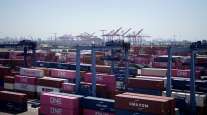Staff Reporter
China’s Port Lockdowns Threaten Domestic Trucking

[Stay on top of transportation news: Get TTNews in your inbox.]
China locking down key port cities because of a new outbreak of the coronavirus could have serious ramifications for trucking in the United States.
“We are seeing a slowdown in cargo volume due to COVID-19 shutdowns in Shanghai,” Port of Long Beach Executive Director Mario Cordero told Transport Topics. “We would expect to eventually see a corresponding uptick or even a slight surge in cargo volume as the supply chain would be expected to catch up. This has been the pattern in the past as China has dealt with COVID outbreaks.”
FourKites data from May 3 shows the two-week average shipment volume for loads traveling from China to the United States was down 20% as of April 29, compared with the day before lockdowns went into effect in Shenzhen and Shanghai on March 12. Still, it does show some signs of recovery with average shipment volumes being down 36% as of April 20.

Closser
“I think we’re going to see the ripple effect pretty quickly,” said Ryan Closser, director of network enablement at FourKites. “There’ll be downstream ramifications pretty quickly. It is going to start at the ports immediately. But I think all the trucking companies are going to feel it.”
Closser noted the slowdown could then be followed by a surge of ships when the lockdowns lift. This could cause bottlenecks when they finally reach the West Coast. He estimates that another two to four weeks of lockdowns could cause serious issues domestically.
“The longer this goes on, the bigger potential for pretty serious disruptions,” Closser said. “The domestic freight market is going to have issues because there will be no freight to move. There will be no raw materials coming in from China to the U.S. so production could potentially shut down. So then say that China opens back up again and things are flowing through and they’re working through that backlog, there is then a crush of boats that starts toward ports again.”
The domestic freight market is going to have issues because there will be no freight to move.
Ryan Closser, FourKites director of network enablement
FourKites data also shows the two-week average ocean shipment volume for the Port of Shanghai was down 22% compared with March 12. Its ocean dwell times for import shipments surged 216% to 10.9 days. Export dwell times increased 31% to 6.4 days. For the rest of the country, exports dwell times increased 18% to 8.6 days and import dwell times did not increase.
“Cargo is still finding its way out of the ports throughout central China,” Port of Los Angeles spokesman Phillip Sanfieldsaid. “We’re watching closely, but we haven’t seen a precipitous drop-off of cargo leaving Asia, specifically China. For instance, we’re seeing about the same amount of vessels, maybe a handful less being processed in April here at the Port of LA compared to March and February.”
Werner Enterprises CEO Derek Leathers addressed the issue during a quarterly earnings call May 3. He noted when the restrictions clear and more vessels appear en route, it could double down on the normal seasonal uptick in freight.

Leathers
“There’s been a lot of conversations about ports clearing up and decongesting,” Leathers said. “I would argue that’s much more related to the lack of inbound than it is to any kind of productivity gains that have taken place.”
Leathers predicts the backlog of vessels could start arriving on the West Coast in late June but adds it could be longer.
Werner ranks No. 17 on the Transport Topics Top 100 list of the largest for-hire carriers in North America. Werner Logistics is No. 33 on the TT Top 100 list of the largest logistics companies.
“The ongoing lockdown in Shanghai has had a large impact on the supply chain industry with the potential for a broader domino effect,” said Adam Compain, senior vice president of supply chain insights at Project44. “Shuttered manufacturing, a 237% rise in China import delays and quarantined workers have all impacted the ability to move goods effectively in and out of China.”

Mossman
Frankie Mossman, chief customer officer at Overhaul, believes the full impact of the lockdowns have not been felt because of the bottlenecks in the Asia-Pacific region. But once that breaks, she noted, it could cause a whole new bottleneck on the West Coast.
“Shanghai is the one of the largest commercial ports that China has,” Mossman said. “The ripple effect of the Shanghai port is going to be the biggest one, because that is their highest volume port.”
Mossman also warned the lockdowns have worsened an ongoing issue with unavailable shipping containers in China.
“They locked down key metropolitan areas,” Mossman said. “They shut down the road network. Nobody could move without permission. And even if drivers could move, they had to be quarantined, depending on the day and the policy, up to 14 days before anything could actually move. So, equipment is in the wrong place.”
Want more news? Listen to today's daily briefing below or go here for more info:




